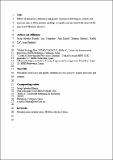Por favor, use este identificador para citar o enlazar a este item:
http://hdl.handle.net/10261/56407COMPARTIR / EXPORTAR:
 SHARE SHARE
 CORE
BASE CORE
BASE
|
|
| Visualizar otros formatos: MARC | Dublin Core | RDF | ORE | MODS | METS | DIDL | DATACITE | |

| Campo DC | Valor | Lengua/Idioma |
|---|---|---|
| dc.contributor.author | Blanch, J. | - |
| dc.contributor.author | Sampedro, L. | - |
| dc.contributor.author | Llusia, Joan | - |
| dc.contributor.author | Moreira Tomé, Xoaquín | - |
| dc.contributor.author | Zas Arregui, Rafael | - |
| dc.contributor.author | Peñuelas, Josep | - |
| dc.date.accessioned | 2012-09-17T14:58:23Z | - |
| dc.date.available | 2012-09-17T14:58:23Z | - |
| dc.date.issued | 2012 | - |
| dc.identifier | doi: 10.1111/j.1438-8677.2011.00492.x | - |
| dc.identifier | issn: 1435-8603 | - |
| dc.identifier.citation | Plant Biology 14: 66- 72 (2012) | - |
| dc.identifier.uri | http://hdl.handle.net/10261/56407 | - |
| dc.description.abstract | We studied the effects of phosphorus fertilisation on foliar terpene concentrations and foliar volatile terpene emission rates in six half-sib families of Pinus pinaster Ait. seedlings. Half of the seedlings were resistant to attack of the pine weevil Hylobius abietis L., a generalist phloem feeder, and the remaining seedlings were susceptible to this insect. We hypothesised that P stress could modify the terpene concentration in the needles and thus lead to altered terpene emission patterns relevant to plant-insect signalling. The total concentration and emission rate ranged between 5732 and 13,995οg·g -1DW and between 2 and 22οg·g -1DW·h -1, respectively. Storage and emission were dominated by the isomers α- and β-pinene (77.2% and 84.2% of the total terpene amount amassed and released, respectively). In both resistant and susceptible families, P stress caused an increase of 31% in foliar terpene concentration with an associated 5-fold decrease in terpene emission rates. A higher terpene content in the leaves implies that the 'excess carbon', available under limiting growth conditions (P scarcity), is allocated to terpene production. Sensitive families showed a greater increase in terpene emission rates with increasing P concentrations, which could explain their susceptibility to H. abietis. © 2011 German Botanical Society and The Royal Botanical Society of the Netherlands. | - |
| dc.language.iso | eng | - |
| dc.publisher | Thieme | - |
| dc.rights | openAccess | - |
| dc.title | Effects of phosphorus availability and genetic variation of leaf terpene content and emission rate in Pinus pinaster seedlings susceptible and resistant to the pine weevil, Hylobius abietis | - |
| dc.type | artículo | - |
| dc.identifier.doi | 10.1111/j.1438-8677.2011.00492.x | - |
| dc.date.updated | 2012-09-17T14:58:24Z | - |
| dc.description.version | Peer Reviewed | - |
| dc.type.coar | http://purl.org/coar/resource_type/c_6501 | es_ES |
| item.fulltext | With Fulltext | - |
| item.languageiso639-1 | en | - |
| item.openairecristype | http://purl.org/coar/resource_type/c_18cf | - |
| item.openairetype | artículo | - |
| item.cerifentitytype | Publications | - |
| item.grantfulltext | open | - |
| Aparece en las colecciones: | (MBG) Artículos (CEAB) Artículos | |
Ficheros en este ítem:
| Fichero | Descripción | Tamaño | Formato | |
|---|---|---|---|---|
| Effects_phosphorus_availability.pdf | 197,94 kB | Adobe PDF |  Visualizar/Abrir |
CORE Recommender
SCOPUSTM
Citations
24
checked on 21-abr-2024
WEB OF SCIENCETM
Citations
24
checked on 28-feb-2024
Page view(s)
399
checked on 24-abr-2024
Download(s)
426
checked on 24-abr-2024
Google ScholarTM
Check
Altmetric
Altmetric
NOTA: Los ítems de Digital.CSIC están protegidos por copyright, con todos los derechos reservados, a menos que se indique lo contrario.
